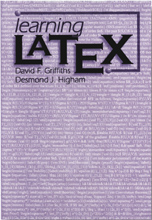
When Karl Berry and I discussed the current situation with LaTeX books for beginners, he mentioned the old text by Griffiths and Higham as an example of the one made “just right”. I was surprised to find that the book is still in print. Thus I ordered a copy for myself and read it.
I must say Karl was right: this is indeed an incredibly good introduction to LaTeX. Even today, when many good books are available for beginners, this one stands out.
First, it is incredibly short. The great free book by Tobias Oetiker et al. used to be called LaTeX2e in 120 minutes, where 120 referred to the number of printed pages. On my machine texdoc lshort now gives me LaTeX2e in 157 minutes, and the number grows every time I update my copy of the TeX Live distribution. Well, Learning LaTeX has 53 pages of main text (not counting preface, table of contents, appendices, index and bibliography), and 94 pages total. Of course, one cannot write a LaTeX book of this size without making white lies by omission, and the authors admit as much on page 1.
For example, here is how the authors introduce infinitely stretchable lengths. They start with the \vspace{⟨length⟩} command and explain its usage. Then they say, oh, by the way, there is an infinite length \fill, so \vspace{\fill} will push your text down to the bottom of the page unless counterbalanced by another infinite spring below. Of course an advanced user knows that there are three infinities in TeX (0pt plus 1 fil, 0pt plus 1 fill and 0pt plus 1 filll), but this might be confusing for a beginner, so the authors’ brief explanation seems to be a smart choice.
Another example of the authors’ unique style is the way floats are introduced. This is rather a “hard” topic, and many beginners have a problem grasping the concept (“I’ve put my table here—why did it travel to the next page?”). The authors explain tabular, show how to create the table, and then say, by the way, if you want a caption and number for the table, put everything inside a table environment. And by the way, the table will not interrupt your text, but will be placed in some proper place. Oh, and you can do the same with the figures too.
There are numerous short examples, each well written and to the point, often with a distinct sense of humor (e.g. the authors demonstrate spacing after abbreviations with the phrase, Incomplete lists etc. are signs of lazy writing).
This writing is easy to read, and may seem easy to write, but this latter impression is misleading. As any experienced author would agree, it is very hard to write “easy”. There is much work and thought behind the seemingly effortless passages. Thus I was not surprised when I read in the preface that this book is based on the lectures and courses the authors taught several times and polished over time.
The book is old, and this shows. It contains a section about LaTeX 2.09 and the “new” features of LaTeX2e; PDF format is not mentioned at all, as well as such now-popular features as non-CM fonts, hyperlinks, colors, etc. However, one of the strengths of good software is that the knowledge of it does not become obsolete easily. Thus, it is a testament to (LA )TeX and the authors’ efforts that this book can still be used as a first LaTeX book or as a basis for a short practical course.
It would be also interesting to see a book using the same approach but updated with the new material. Making it as concise and easy to read as this one will be a challenge.